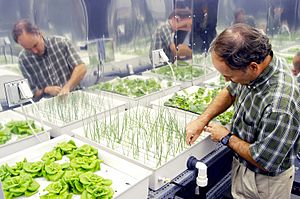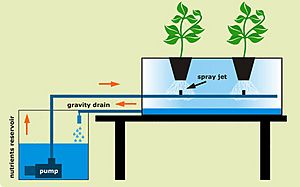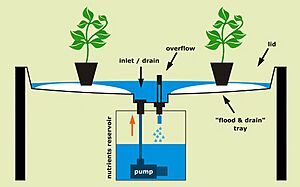Hydroponics facts for kids
Hydroponics (also called Hydroculture) is a special way of growing plants without using soil. Instead, plants get all the nutrients they need directly from water. The plant food is mixed into water, creating a special "nutrient solution" for the plants to live in. You can grow many things this way, like vegetables, flowers, and herbs.
This idea is quite old! One of the first books to talk about growing plants without soil was Sylva Sylvarum by Francis Bacon in 1627. After that, growing plants in water became a popular way for scientists to do research. In 1929, William Frederick Gericke from the University of California at Berkeley started telling everyone that this water-based growing method could be used to grow big amounts of food crops.
Contents
How to Grow Plants with Hydroponics
There are many cool ways to grow plants using hydroponics. Here are some of the most common methods:
Static Solution Culture
This method is like giving plants a bath! Plants float or sit in a container filled with nutrient water. The water doesn't move or flow. It just stays "static" (still). A system makes sure the plants' roots don't dry out.
A small problem with still water is that algae can grow. Algae are tiny green plants that can steal nutrients from your plants. To stop this, you can cover the container with something dark, like black plastic, to block the light from reaching the roots. You also need to change the water every week or two to keep the nutrients fresh.
Continuous-Flow Solution
This method keeps the water moving all the time! Plants are often placed in a shallow tray, and the nutrient water flows continuously over their roots. Imagine a tiny river for your plants!
One popular way to do this is called the Nutrient Film Technique (NFT). The water flows as a very thin "film" over the roots. A big advantage of this system is that all the nutrient water can be stored in one large tank. If you need to add more nutrients, it's easy to do it in the tank.
Usually, this system works using gravity. The storage tank is placed higher than the plants. The water trickles down past the plant roots and then collects in a lower tank. From there, a pump sends it back up to the higher tank to start again. This method uses nutrients very well and helps the roots get lots of oxygen, which is super important for healthy growth.
The main challenge is that if the pump or circulation system stops working, the plants won't get water for long. Also, the trays need to be perfectly sloped so the water flows smoothly and doesn't get stuck in puddles.
Aeroponics
Aeroponics is a very cool method where plant roots hang in the air! Instead of sitting in water, the roots are in a closed chamber. A special sprayer then mists the roots with a fine spray of nutrient water. This mist can be sprayed all the time or just every now and then.
The big benefit of aeroponics is that the roots get tons of oxygen from the air. This helps them grow really well. Richard Spooner invented this system in 1983. It's great for growing many different crops, like potatoes, tomatoes, and leafy greens.
NASA is even interested in aeroponics because it's easier to manage a spray in space (where there's no gravity) than to handle lots of liquid water. Plants grown this way also use less water and nutrients than other hydroponic methods. Plus, if you want to move an aeroponically grown plant into soil, it usually adjusts very easily without slowing its growth. The main downside is that building and keeping up an aeroponic system can be more expensive.
Passive Sub-Irrigation
This method is also known as "semi-hydroponics." Here, plants grow in a material that holds water but isn't soil. Think of things like special clay balls, vermiculite, or coconut husks. These materials hold water and have lots of air pockets, but they don't directly feed the plant.
Water is added to the bottom of the container, and the material soaks it up, keeping the plant roots wet. The material also helps keep the roots separated so they can get enough air. This method is easy to set up and is good for plants like orchids or bromeliads, which naturally like warm, damp air around their roots.
Ebb and Flow Sub-Irrigation
This method is also called "Flood and Drain." It uses a large container of nutrient water placed below the plants. Every so often, a pump (or you, if it's a small system) lifts the water up to "flood" the plants' growing tray. The plants soak up the water and nutrients. After a short time, the water then "drains" back down into the main container.
This is a simple system to build and can be easily controlled with a timer to automatically flood and drain the plants.
Deep Water Culture
In Deep Water Culture (DWC), plants hang with their roots directly in a tank of nutrient water. The plants are usually held in small net pots, and their roots dangle down into the water.
To make sure the roots get enough oxygen, air is pumped into the water, creating bubbles. This is super important because roots need oxygen to breathe, just like we do!
Bubbleponics
Bubbleponics is a special trick often used with Deep Water Culture, especially for young plants. When plants are just starting to grow roots, this method pumps water and nutrients through a special "air stone" (like the ones in fish tanks). This creates lots of tiny bubbles and adds a very high amount of oxygen to the water. This extra oxygen really helps young roots grow strong and fast! It's usually only used for the first few weeks while the plants are forming their root clumps.
Benefits of Hydroponics
Hydroponics has many great advantages:
- Fresher Produce: Hydroponically grown plants can sometimes be sold while they are still alive, which means they stay fresh for much longer!
- Perfect Watering: You never have to worry about giving your plants too much or too little water. The system takes care of it.
- Grow Anywhere: Hydroponics is perfect for places where soil isn't good, like very cold areas (Antarctica!), or even on space stations and future space colonies.
- Great for Learning: It's an excellent way to learn about plants and how they grow, and it's used a lot in plant research.
- No Soil Needed: You don't need any dirt, which means less mess!
- Clean Crops: Since there's no soil, your plants stay cleaner and aren't exposed to soil-borne diseases.
- Less Water Used: Hydroponic systems often use much less water than growing plants in soil.
- More Sunlight: Plants in hydroponic systems can often get more sunlight, helping them grow bigger and faster.
- Fewer Pests: Without soil, there are usually fewer bugs and other pests trying to eat your plants.
Images for kids
See also
 In Spanish: Hidroponía para niños
In Spanish: Hidroponía para niños



















